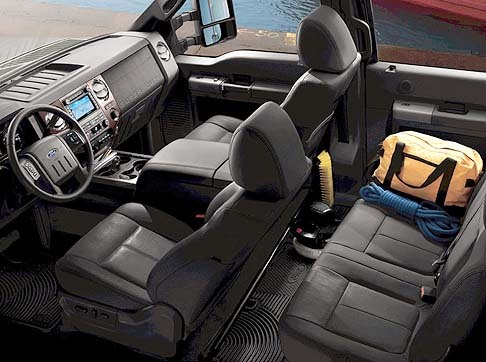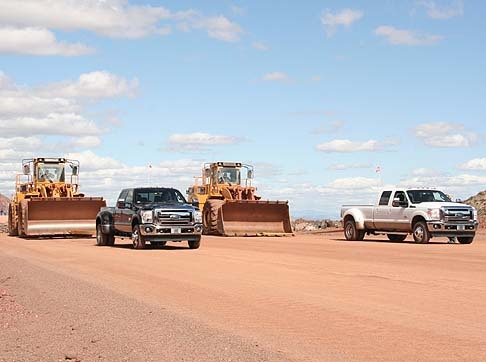I love the new front end and grill. Ford has a nack for making their trucks look pretty badass.
From Autonet.ca
Full Gallery
Article by Rob Daly
There’s a whole lot of ‘new’ to talk about with the 2011 Ford Super Duty pickup line — and one very significant ‘old’ that will surprise many.
Already among the industry leaders in heavy duty pickups, Ford is taking yet another big step forward with a completely revised Super Duty just three years after its last major overhaul. At the heart of this re-do is a change in powertrain supplier: after a long-term relationship with engine producer Navistar, Ford takes over the design and production of its own diesel engine for use in trucks ranging from the F-250 to the F-550.
Click here to find out more!
And Ford’s engine design team found plenty of ideas outside the box to make the Super Duty’s future look brighter than ever. The most fundamental change is so basic, many would never consider making it: instead of arranging the engine architecture to route exhaust gases to the outside of the engine V (like every production V8 or V6 in the last 60 years), Ford’s new 6.7-litre PowerStroke collects exhaust gases in an inboard manifold system. This reversal allows for easier collection of the exhaust into a two-level intercooler (it cools the gases down to about half the engine’s normal operating temperature) located right on top of the engine.
The cooled gases are then directed to a Honeywell-designed, dual-stage turbocharger that features two variable-geometry vanes mounted on a single compressor shaft. The aim of this compact turbocharging solution is quick response for reduced turbo lag and high gas volumes for better output at all engine speeds. Ford designers say the engine reutilizes from 30% to “over 50%” of its exhaust gases — a good first step on the road to meeting demanding new emissions standards.
Despite these improvements in efficiency, the new Super Duty diesel needed additional changes to meet emissions. A urea-based additive system (the liquid should retail for less than a dollar per litre, with about 20 litres lasting 12,000 km, is synched with the truck’s oil change regimen to make the grade.
Media gearheads at Ford’s launch in Arizona were enthusiastic about the changes, citing vastly improved access to major components as a big seller with fleets and individual enthusiasts alike.
Ford also reworked the engine’s middle and lower components, opting for aluminum cylinder heads (a six-bolt head configuration should help prevent gasket issues) and a streamlined crankcase that utilizes compacted graphite iron — a material that’s been around for years, but that has only recently been adopted by engine manufacturers like Rolls-Royce and Caterpillar. Ford’s engine gurus say the switch allowed them to pare down the lower structures significantly while increasing overall strength. Together, these changes reduced the engine weight by a truly significant 72.5 kg.
About 22.5 of those are given back with the truck’s new six-speed automatic transmission — but it’s weight well spent. Ford reconfigured the transmission to incorporate a direct access power takeoff right behind the torque convertor. A built-in PTO may not make a difference to every user, but there are plenty of buyers out there who will appreciate the ease with which outfitters can connect generators, pumps, or other auxiliary equipment.
The heavy-duty tranny works with either the 6.7-litre diesel or the all-new 6.2-litre gas V8 (replacing the 5.4-litre Triton) to create some truly impressive numbers: A fuel-economy challenge for media types en route to Phoenix produced a winning mark of about 8.7 L/100km in the diesel and an equally respectable 12.4 L/100km in the gasoline model. Not bad for engines producing such horsepower numbers and torque figures.
Ford has also introduced a whole set of improvements to its business-based Work Solutions system, including an available radio frequency tagging system called Tool Link: if a tagged tool isn’t returned to the truck’s box, the driver is alerted before he or she pulls away. No more leaving expensive tools on a jobsite! Another system, Crew Chief, provides detailed telematics to allow business operators to track maintenance and improve dispatch efficiencies.
The truck’s interior is reworked to incorporate some new materials, and the designers decided to go with user feedback by adopting the excellent seats introduced in last year’s F-150. You simply won’t find a quieter, more comfortable production work truck on the market.
Which brings us back to the one significant ‘old’ I mentioned earlier. The new 2011 Super Duty pickup, hitting sales lots sometime in May 2010, will be available at almost the same base prices as the previous year’s models. With better fuel economy, power, comfort and productivity than the model it replaces, that’s an ‘old’ buyers will be glad Ford kept.
Price Range: $35,399 - $74,699




From Autonet.ca
Full Gallery
Article by Rob Daly
There’s a whole lot of ‘new’ to talk about with the 2011 Ford Super Duty pickup line — and one very significant ‘old’ that will surprise many.
Already among the industry leaders in heavy duty pickups, Ford is taking yet another big step forward with a completely revised Super Duty just three years after its last major overhaul. At the heart of this re-do is a change in powertrain supplier: after a long-term relationship with engine producer Navistar, Ford takes over the design and production of its own diesel engine for use in trucks ranging from the F-250 to the F-550.
Click here to find out more!
And Ford’s engine design team found plenty of ideas outside the box to make the Super Duty’s future look brighter than ever. The most fundamental change is so basic, many would never consider making it: instead of arranging the engine architecture to route exhaust gases to the outside of the engine V (like every production V8 or V6 in the last 60 years), Ford’s new 6.7-litre PowerStroke collects exhaust gases in an inboard manifold system. This reversal allows for easier collection of the exhaust into a two-level intercooler (it cools the gases down to about half the engine’s normal operating temperature) located right on top of the engine.
The cooled gases are then directed to a Honeywell-designed, dual-stage turbocharger that features two variable-geometry vanes mounted on a single compressor shaft. The aim of this compact turbocharging solution is quick response for reduced turbo lag and high gas volumes for better output at all engine speeds. Ford designers say the engine reutilizes from 30% to “over 50%” of its exhaust gases — a good first step on the road to meeting demanding new emissions standards.
Despite these improvements in efficiency, the new Super Duty diesel needed additional changes to meet emissions. A urea-based additive system (the liquid should retail for less than a dollar per litre, with about 20 litres lasting 12,000 km, is synched with the truck’s oil change regimen to make the grade.
Media gearheads at Ford’s launch in Arizona were enthusiastic about the changes, citing vastly improved access to major components as a big seller with fleets and individual enthusiasts alike.
Ford also reworked the engine’s middle and lower components, opting for aluminum cylinder heads (a six-bolt head configuration should help prevent gasket issues) and a streamlined crankcase that utilizes compacted graphite iron — a material that’s been around for years, but that has only recently been adopted by engine manufacturers like Rolls-Royce and Caterpillar. Ford’s engine gurus say the switch allowed them to pare down the lower structures significantly while increasing overall strength. Together, these changes reduced the engine weight by a truly significant 72.5 kg.
About 22.5 of those are given back with the truck’s new six-speed automatic transmission — but it’s weight well spent. Ford reconfigured the transmission to incorporate a direct access power takeoff right behind the torque convertor. A built-in PTO may not make a difference to every user, but there are plenty of buyers out there who will appreciate the ease with which outfitters can connect generators, pumps, or other auxiliary equipment.
The heavy-duty tranny works with either the 6.7-litre diesel or the all-new 6.2-litre gas V8 (replacing the 5.4-litre Triton) to create some truly impressive numbers: A fuel-economy challenge for media types en route to Phoenix produced a winning mark of about 8.7 L/100km in the diesel and an equally respectable 12.4 L/100km in the gasoline model. Not bad for engines producing such horsepower numbers and torque figures.
Ford has also introduced a whole set of improvements to its business-based Work Solutions system, including an available radio frequency tagging system called Tool Link: if a tagged tool isn’t returned to the truck’s box, the driver is alerted before he or she pulls away. No more leaving expensive tools on a jobsite! Another system, Crew Chief, provides detailed telematics to allow business operators to track maintenance and improve dispatch efficiencies.
The truck’s interior is reworked to incorporate some new materials, and the designers decided to go with user feedback by adopting the excellent seats introduced in last year’s F-150. You simply won’t find a quieter, more comfortable production work truck on the market.
Which brings us back to the one significant ‘old’ I mentioned earlier. The new 2011 Super Duty pickup, hitting sales lots sometime in May 2010, will be available at almost the same base prices as the previous year’s models. With better fuel economy, power, comfort and productivity than the model it replaces, that’s an ‘old’ buyers will be glad Ford kept.
Price Range: $35,399 - $74,699






